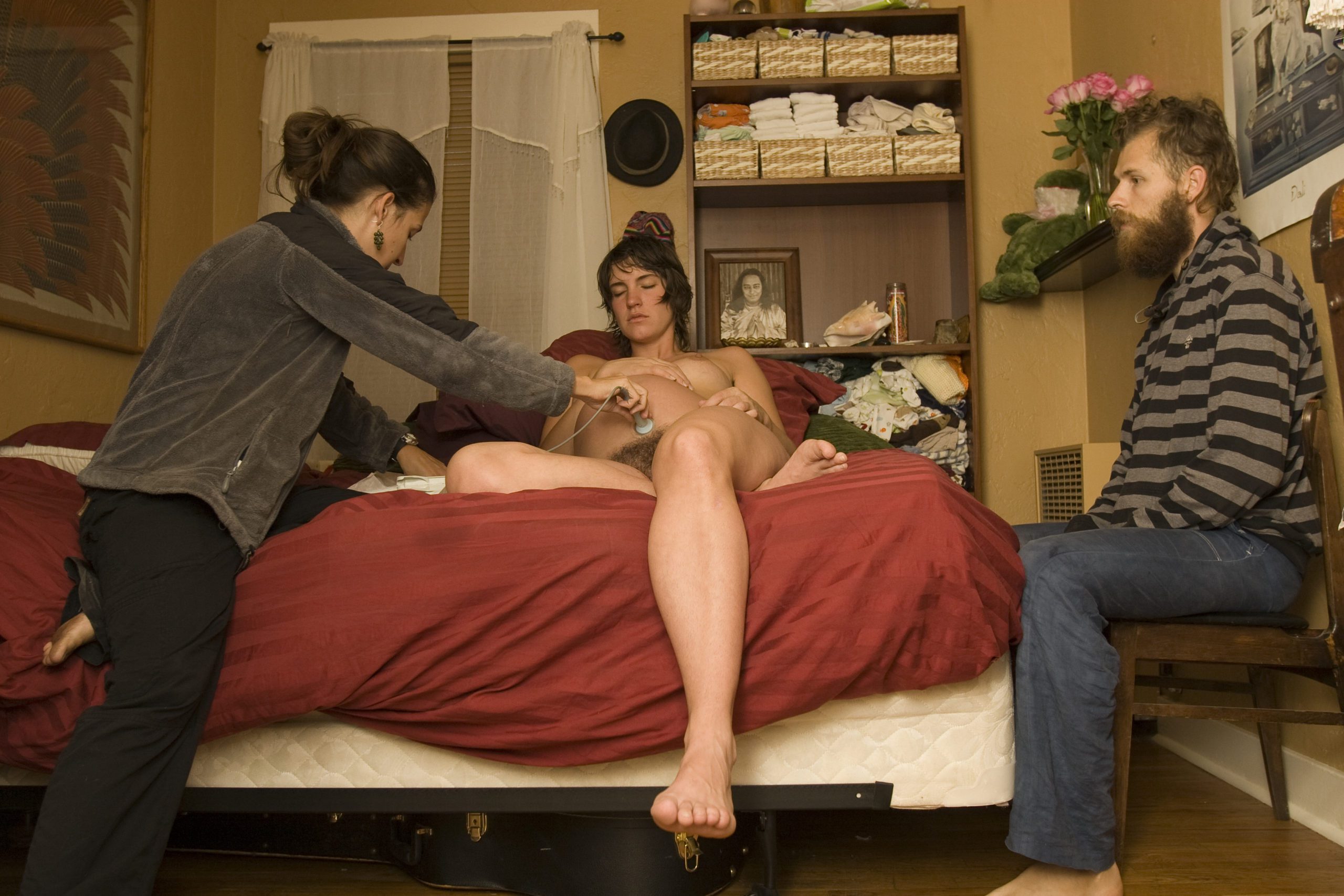Written by Emma Tillman
In the United States, we have reached a critical mass of separation from our essential selves, and in no more clear place does this show up than in the way we birth. The predominant system forces us as birthing women to conform to a set of rules and regulations that are laid out by curves, graphs, and charts. These systems are designed to punish our spiritual and emotional selves if we dare to color outside the lines. And how can we not? Birth was designed to be beyond our control, and that is one of its gifts. Perhaps one of the most important aspects of this attempt at control is in the realm of the second stage of labor, or what is commonly known as pushing. In this essay I will explore how directed pushing has detrimental effects to a woman’s spiritual and emotional well being, while physiological pushing allows the birthing woman to be in touch with her body and her baby for a powerful birth experience. Each have a radical effect on the confidence in her body and early mothering to her newborn baby. In addition I will discuss the role of birth attendants in facilitating this process.
In Robbie Davis Floyd’s critical essay, The Technocratic, Humanistic, and Holistic paradigms of Childbirth, she says “The technocratic model stresses mind-body separation and sees the body as a machine; the humanistic model emphasizes mind-body connection and defines the body as an organism; the holistic model insists on the oneness of body, mind, and spirit and defines the body as an energy field in constant interaction with other energy fields.” This is what the hospital has given us in relation to birth. It initiates us as mothers into the predominant culture where we place our power into the hands of outside authority. A routine practice in the hospital is to have a woman begin pushing as soon as she is 10 centimeters dilated, even if she has no physiological urge. If this process occurs smoothly, the woman assumes she was taken care of by the system. If this process is not smooth, and many interventions are made, the woman assumes she is defective. A common narrative is that she was grateful to be in a hospital when everything “went wrong” and carries with her the story of her defective body for the rest of her life. This effect can not only be detrimental to the woman’s sense of self and her mothering experience, but affect future generations of women.
In 1986, my mother stepped foot into the hospital at 1pm on a March day. She had been laboring beautifully since around 7am, and when she was checked at the hospital she was near completion. An hour or two later she was checked again and found to be 10 centimeters. She was immediately directed to push. After 5 hours, a vacuum attempt, and utter exhaustion, the doctors informed my mother that she would need a c-section, as my head was “stuck”. She was wheeled to the operating room where suddenly, she felt something shift and began the physiologic urge to push. But at that point, it was too late. A c-section was performed and I was born. My mother carries with her the story that she was unable to birth me until this very day, and I heard it many times as a child. When it came time to give birth to my own baby, I also had a long latent phase between completion and the urge to push, which for me did not come before I was transported to the hospital for a c-section, as I had a breech baby and my provider was not comfortable with the many hours spent with no descent. I believe my mother’s story of her inability to birth greatly affected me, and showed up undeniably in my own labor.
Due to scientific research in the last 50 years, there is little doubt that birthing in a private or home setting with little to no interference contributes greatly to a normal labor with a positive outcomes for mother and baby. Michel Odent, French obstetrician and childbirth specialist, has devoted his life to observing and writing about this subject. He contends that there is no “second stage”, only a passage between labor and the fetus ejection reflex, during which the baby emerges. This state happens physiologically without any voluntary effort, and is inhibited by interference. A woman’s body knows exactly what to do. Providers must only observe with the utmost respect in order for the hormonal process of birth to unfold, thus triggering the symphony of hormones that contribute to a mother’s profound spiritual and emotional experience of birthing her baby. Odent goes so far as to recommend avoiding even direct eye contact or verbal communication of any kind during this time. When the woman beholds the power of her body in this way, completely unfettered, there is no greater feeling of accomplishment and bonding with baby.
Birth attendants must work to not interfere with this physiologic process. I am less interested in the hospital model of coached pushing by nurses and doctors which we know to be quantifiably detrimental, but rather in the midwifery model, when birth attendants are either tired, misinformed or misunderstanding a birth and encourage a woman to push, or perhaps more importantly not to push. These tactics disturb the flow of labor and discourage a woman from being completely in touch with her own body.
Gloria Lemay cautions against performing what she calls the “8 centimeter check”, a vaginal exam performed by midwives when a woman (particularly a primip, or first time mother) announces an urge to push. She reminds us that at this stage, especially with a primips, the labor may have been long, and the midwives and other attendants may be tired. There may be a sense of excitement when a woman announces this urge. However it is often not quite time for the woman to push her baby out, and there may be a palpable sense of disappointment in the room, or a psychic urge to hurry up the process, which may affect the birthing woman if felt. Lemay encourages the birth attendant to look rather for outward signs of progress by simply quietly observing, and only if needed address anything psychological that seems to be holding up descent. This is all in order for the mother to experience her natural fetus ejection reflex and feel that she has given birth unencumbered by “help” from the midwives. Perhaps as important for midwives and birth attendants as the urge to hurry along the process of pushing is the opposite, or the intentional slowing down of the process.
In Dr Rachel Reed’s article, The Anterior Cervical Lip: How to Ruin a Perfectly Good Birth, she outlines the importance of unlearning the supposed wisdom we have often been given as midwives on when and how to push. Midwives often interfere with this process if a woman is having an active urge to push but in the midwife’s opinion is “not ready” due to a cervical lip. Dr Reed shows through medical studies that a woman’s likelihood of developing a swollen cervix (one of the fears of pushing on a cervical lip) or other cervical or birth injuries while pushing on a lip does not increase. The babies head is very likely to push the lip out of the way. There is also an urge on the part of midwives to slow to slow down the process of emergence to prevent tearing. Dr Reed goes on to relate anecdotal and scientific evidence that if a woman is left to her own instinctual urges, she will slow the arrival of the baby’s head on her own with touching or light pressure on her vulva in order to better control emergence. This evidence shows the power of women’s wisdom to know exactly what to do to create an optimal birth for themselves and their babies when they are left to be led by their physiology. Jeannine Parvati Baker’s line, “every woman a midwife.” applies beautifully in this context.
To conclude, I will say that the small but powerful movement of women taking back birth by trusting in its wisdom is one that has an immediate effect on culture. It produced women who are confident mothers, midwives who are compassionate guides, and babies who are received and witnessed by a birth that is truly best for them. It will also have a gradual effect, as more women and birth attendants wake up to the reality of what we have been taught versus what we are made to do we will see a rise in the aforementioned groups. Women, babies, and midwives are the future of our society as we step into these new and uncertain times, and each component is equally as important in walking through the portal of life to regain wisdom and self knowledge. I will end this essay by quoting Jeannine Parvati Baker again, from the birth story of her daughter Quinn. What a fantastic way to birth a baby, and for a baby to enter this world!
“I feel the baby come down. The sensation is ecstatic… this time the pulse of birth feels wonderful! I am building up to the birth climax after nine months of pleasurable foreplay. With one push the babe is in the canal. THE NEXT PUSH BRINGS HIM DOWN, DOWN INTO THAT SPACE JUST BEFORE ORGASM WHEN WE WOMEN KNOW HOW GOD MUST HAVE FELT CREATING THIS PLANET.”
Bibliography, sources used
BAKER, Jeannine Parvati. Quinn’s Waterbirth
http://www.susunweed.com/herbal_ezine/November06/childbearing.htm
FLOYD, Robbie Davis. The Technocratic, Humanistic, and Holistic Models of Birth
https://www.researchgate.net/publication/230669902_The_Technocratic_Humanistic_and_Holistic_Models_of_Birth
LEMAY, Gloria. Pushing for Primips.
ODENT, Michel. Insights into Pushing: The Second Stage as a Disruption of the Fetus Ejection
Reflex. http://healingpassages.org/wp-content/uploads/Odent-Insights-into-Pushing.pdf
REED, Dr. Rachel. The Anterior Cervical Lip: How to Ruin a Perfectly Good Birth
The Anterior Cervical Lip: how to ruin a perfectly good birth





Hello!! This essay it’s amazing and I would like to know if I can share it in my blog, with all the proper credits, of course!. My platform is dedicated to Spanish speaking women, so I would have to translate it. If you want to check it out it’s http://www.mujer.love
Thank you!!